Introduction
Philosophy – Principle of Homeopathy
Introduction
The system of Homeopathy is based on The Law of Similars. It is a healing system founded by the S.C.F. Hahnemann, a German Physician who was born in Meissen 1755, and died in Paris 1843.[1] Hahnemann expressed this principle with the Latin motto “Similia Similibus Curentur,”[2] which means, “Let similars be treated with similars”. Hahnemann maintained that this is a basic law of cure. In a nutshell, homeopaths seek to cure people of diseases by giving them remedies based on the Law of Similars.
When a homeopathic physician is able to recognise what is to be cured in the patient and is able to match this to a remedy, he will have understood the art of prescribing in homeopathy. Other measures to achieve health are lifestyles changes, nutrition and hygiene. The principles and methods of Homeopathy are laid out in a book called the Organon of the Art of Healing written by S.C.F. Hahnemann.[2]
Philosophy – Principles of Homeopathy
The points below are an explanation based on the Organon sixth edition[2] paragraph 1-22.
Objective of Homeopathic Treatment
The first two paragraphs of the Organon states:
- The physician’s high and only mission is to restore the sick to health, to cure, as it is termed.
- The highest ideal of cure is rapid, gentle and permanent restoration of the health, or removal and annihilation of the disease in its whole extent, in the shortest, most reliable, and most harmless way, on easily comprehensible principles.
From these paragraphs, of the Organon, Hahnemann states the objective of Homeopathy is to affect a cure of the sick individual in a gentle and rapid manner causing the least harm.
Vital force
Vital force means something unseen that determines the health of the individual. Hahnemann said that death is when there is no vital force in the body. He said that the miasm (the true cause of disease) deranges the vital force and prevents it from acting as it would if it was working effectively, it is the vital force that is deranged which causes the disease and cure would ensue when the vital force is made healthy and regains its balance.[2]
In order to cure the Vital force, Hahnemann expounds that what is needed is a therapeutic agent that matches the spirit-like nature of disease in order to remove it and therefore allow the vital force to work unhindered. Hence of the vital force, hence the method he has formulated to produce a homeopathic remedy. He did not come to his method at random or by chance but he conducted meticulous experiments to find the methods to produce the best results in curing the diseased. His methods were published in the sixth Organon.[2]
Method of prescribing
All the symptoms that have deviated from normal are a result of an abnormal functioning in the vital force brought about by the causative agent. These symptoms are analysed from the case taking which is more detailed than in conventional case taking.
The symptoms that have deviated from normal are then matched to a remedy that can cause the same symptoms as studied from the homeopathic Materia Medica which is derived by doing a ‘proving’.
An example:
If a person presents with red eyes, a runny nose and a burning throat, the discharge from the nose is thin and watery yet excoriates the path it runs down by making it red, one would recognise from this the symptoms of a cold. The same symptoms are actually caused by Allium cepa, as anyone who has the experience of peeling and cutting the small red onion (a shallot) would attest to.
This then means that the remedy that would be a similimum* to this case that presents as above would be Allium cepa prepared and dispensed in a homeopathic manner.
*Similimum means the homeopathic remedy that most exactly reproduces the symptoms of any disease.[3]
Materia Medica
Introduction
A Materia Medica is an encyclopedia of medicines which can be used as homeopathic medicines when they are prepared homeopathically. It is a list of the medicines along with details of the symptoms that they produce in a healthy person. The manner of deriving the symptoms is by conducting a proving or what is also known as a drug pathogenetic trail. The homeopath uses the materia medica as a guide in prescribing a suitable remedy selected on symptom similarity.
There are a few of homeopathic materia medicas available now, but the first homeopathic materia medica would be from Hahnemann – the Materia Medica Pura. This is a collection of six volumes altogether.[4]
Homeopathic Remedies, Materia Medica Compilations and Provings
Provings
A method to determine the effects of remedies is by conducting a proving, as stated in paragraph 19-21 of the Organon.It is also known as Homeopathic pathogenetic trials.[5]
The findings of the proving experiments are recorded in various materia medicas, the earliest of which is the Materia Medica Pura.[6] Modern day proving are controlled trials which follow sets of rules that are strictly adhered to and results are checked and double checked to ascertain the symptoms produced by remedies.
Other records in a homeopathic Materia Medica are derived from poisonings and cured cases as recorded in John Henry Clarke’s Materia Medica.[7]
There are many other materia medica compilations. Other frequently used compilations are Kent’s Materia Medica, Boericke’s Materia Medica and Repertory. These are from the earliest Homeopathic authors. A later compilation is Lotus Materia Medica,[8] by Robin Murphy who is a present day author.
Examples of some homeopathic remedies are as follows.
| Remedies of plant origin |
|
| Remedies of Animal origin | |
| Remedies from mineral origin |
An example of how a remedy would be listed in the Materia Medica is as follows. This is an example of the heading from the Beoricke’s Materia Medica.
| Name of the remedy, including its common name | Example: Arnica montana[9], Leapord Bane |
| A short introduction as to its general uses | Example A description on Arnica’s usefulness as well as a brief description of the modalities and conditions that require Arnica as a remedy. Then the properties of Arnica are given under the following headings. Under each heading would be listed the symptoms and signs that are present within the heading. For example, under mind, it would be stated that the Arnica patient will say that he or she is not sick even though it is obvious they are very ill. They also do not like to be touched and will even fear people approaching. |
Below are the headings for each remedy in Boericke’s Materia Medica:
- Mind
- Head
- Eyes
- Ears
- Nose
- Mouth
- Face
- Stomach
- Abdomen
- Stool
- Urine
- Female
- Respiratory
- Heart
- Extremities
- Skin
- Sleep
- Fever
- Modalities
- Relationship
- Complementary
- Dosage
Modalities refer to conditions which make the person who needs arnica worse or better. Conditions might refer to time of day, the weather, states of working or at rest, activities such as eating and talking.
This is followed by a list of remedies that are related to Arnica in its actions and then a list of the remedies that are complementary to Arnica; this is then followed by a list of remedies to compare with Arnica in that they have similar qualities in some aspects.
The last item on the Materia Medica for each remedy is the recommended dosage.
Method of Preparations
The preparation of homeopathic remedies is outlined in the monographs of the Homeopathic Pharmacopoeia[23][24] “Homeopathic preparations are medications obtained by the dynamisation/ potentisation methods as defined in the pharmacopoeia. The preparations are labelled by the Latin name of the drug, substance or compound used, followed by an indication of the dilution or potency”.
There are several Homeopathic Pharmacopoeia’s among which are the HPCUS which is the Homeopathic Pharmacopeia Convention of the United States of America. India has the Indian Homeopathic Pharmacopeia[25] and England has the British Homeopathic Pharmacopeia[26], the latest edition was published in 1999.
Homeopathic remedies are made from plant, mineral and animal sources as well as in some cases from chemicals and morbid matter from diseased parts. The process of making the remedies renders substances which are toxic or noxious in their original state to become non-toxic.
This great variety in origin of raw materials is a result of the basic homeopathic principle, according to which any substance having a proven pharmacological affect upon a healthy individual may become a medication.[27]
Traditional Methods.
Traditional Methods of preparation of Homeopathic remedies is outlined below [28]:
- Selection of raw material.
- Trituration of raw material if insoluble in water or alcohol (grinding with mortar and pestle). (Figure 2)
- Preparation of liquid potencies by dilution and succussion. “Succussion and trituration are the methods by which mechanical energy is delivered to our preparations in order to imprint the pharmacological message of the original drug upon the molecules of the diluents”.
- Medication of blank pellets with liquid potencies.
- Drying of medicated pellets.
- Packaging of medicated pellets in vials for use by homeopathic doctors for their patients and by individuals for themselves and their families.
The entire process of making a Homeopathic medicine consists of the following steps (Figure 1).
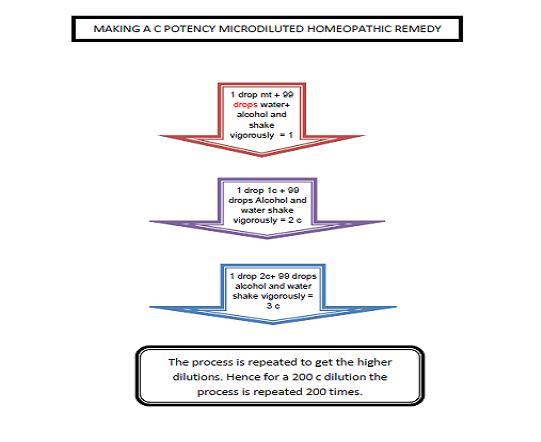
Figure 1: Making a Homeopathic remedy in C dilution
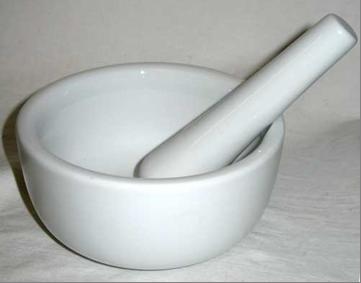
Figure 2: Mortar and pestle is used to grind the raw material to make a remedy
Homeopathic dilutions are prepared according to the Hahnemannian method.[29][30]
- If the successive dilutions are by tenths (one part of substance to nine parts alcohol), they are called decimal solutions. They are labelled by the letter X or D – 1:9 – substance (1 part): alcohol (9 parts).
- If the successive dilutions are made to one-hundredth they are called centesimal. They are denoted by the letters C. 1: 100 – substance (1 part): alcohol (99 parts)
In the sixth edition of the Organon another method of preparation was introduced by Samuel Hahnemann. This potency is a dilution of 1/50,000. This potency is called the LM potency.[2][31] Each dilution is vigorously shaken and this shaking is called the Dynamisation process.[32] These dynamised liquid solutions are then used to prepare further dilutions of Homeopathic remedies. The LM potency is not used by some homeopaths that are not familiar with the method of using LM potencies. This is because the Sixth Organon had not been published until 1921 in the German language.[33] This meant that the spread of Homeopathy using the earlier editions of the Organon had happened before the Sixth Organon was published and it is only recently that with the works of Homeopathic teachers like David Little[34] that the method using the LM dilutions are being taught to present day homeopaths.
Modern Methods
Machines are now used to shake the dilutions in the required number of times and exact measurements are made to ensure that the remedies are precisely made in the dilution that is indicated. One of the machines used. The grinding that was done by hand using mortar and pestle is now done by a machine called a ball mill.[35] The shaking is also done by a machine, one of which is called the Quinn Potentizer.
Forms of the Remedies
Listed below is the forms of remedies are given [29]:
- Remedies may be packed in the form of drops in amber bottles and dispensed by droppers. The usual dose is from 10 to 20 drops under the tongue or in half a glass of water. The dose is to be kept in the mouth for some seconds before swallowing.
- Triturations are tablets or powdered preparations that are made of the remedy added to sugar of milk or sucrose. These remedies are now made by machines such as the ball mill and also modern tabletting machines. The tablets or powders are to be placed under the tongue and allowed to melt slowly.
- Granules are the same as above but are smaller spheres. Granules are made of sachharose-lactose and have to be impregnated with drops of the liquid remedy. This process is called impregnation and can be done manually before dispensing or, for large homeopathic pharmaceutical companies it is done by machine and the remedies are packed for dispensing in individual tubes that dispense one dose at a time.
- Globules are smaller than granules but are of the same mixture and are reserved for higher dilutions. (Figure 3)
- Diskettes are flat round neutral sugar pills and have to be impregnated with the tincture. (Figure 4).
- Impregnation is done by transforming neutral globules and granules into “medications”. A good quality impregnation delivers the liquid remedy evenly in the neutral medium be it diskettes, globules or granules.
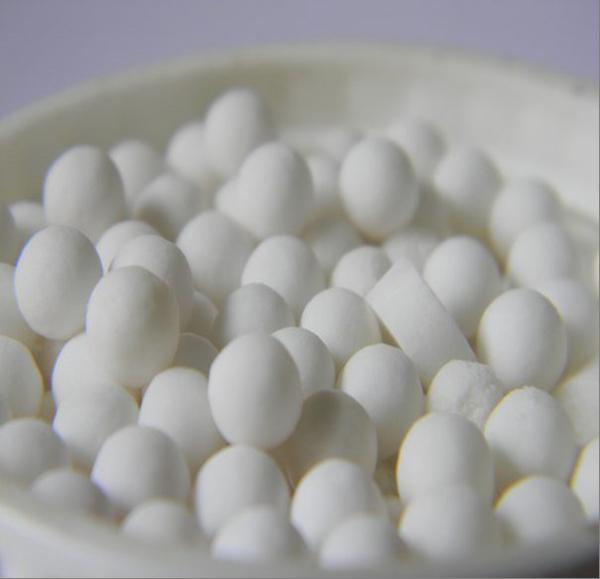
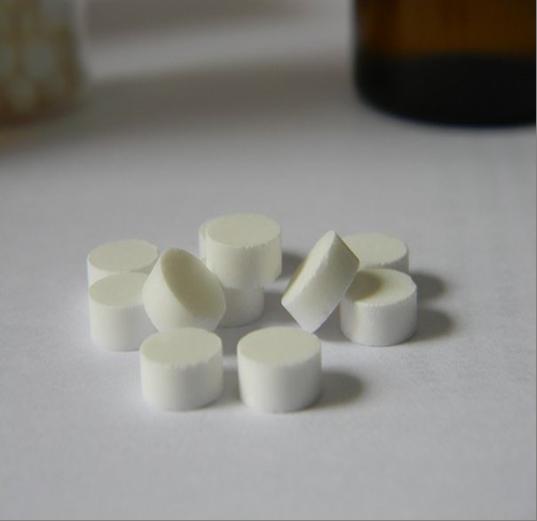
Figure 4: Diskettes
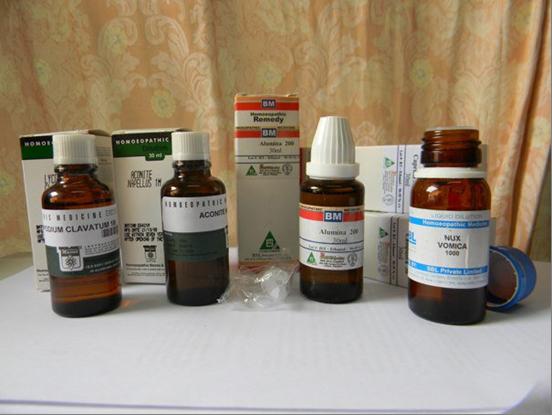
Figure 5: Homeopathic Remedies in the Form of Tincture in Amber Bottles
Effect of Remedies
Proving
A method to determine the effects of remedies is by conducting a proving, as stated in paragraph 19-21 of the Organon.
The findings of the proving experiments are recorded in various Materia Medicas, the earliest of which is the Materia Medica Pura.[5] Modern day proving are controlled trials which follow sets of rules that are strictly adhered to. This set of rules has grown more stringent following good clinical practice guidelines and, a current proving protocol is now available. A homeopathic proving is now considered a clinical trial according to the report by the proving subcommittee of the European Committee for Homeopathy.[36]
Other records in a homeopathic Materia Medica are derived from poisonings and cured cases as recorded in John Henry Clarke’s Materia Medica.[7]
Mechanism of Healing In Homeopathy
The mechanism of healing that occurs when a homeopathic remedy that is a similimum to the disease is taken is as follows:
- The similar homeopathic remedy causes the vital force to react to it and in doing so; it reacts against the disease and eliminates it.
- The Vital Force, now freed from the disease force, is able to work effectively. It will always work to bring the patient to balance on every level (mental, emotional and physical). This is true healing[2] (Figure 6).
In paragraph 22 of the Organon[2], it is stated that the curative powers of medicines exist only because they can produce symptoms in the healthy and remove them from the sick (Figure 7).
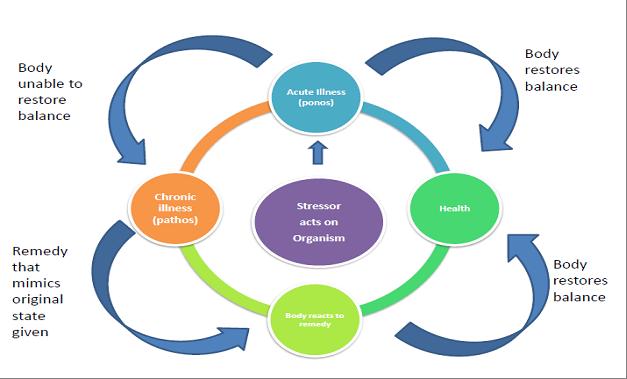
Figure 6: Homeopathic Theory of Disease
Explanation (Figure 6): A stressor or causative agent acts against the organism, this agent causes the body to become acutely ill. The body through the healthy vital force then restores balance and health is restored. When the body is not able to restore balance, the illness becomes chronic. Then a homeopathic remedy which mimics the original state of the organism is introduced and the vital force then acts against the homeopathic remedy and because it is similar to the original illness, the body through the vital force is restored to health.
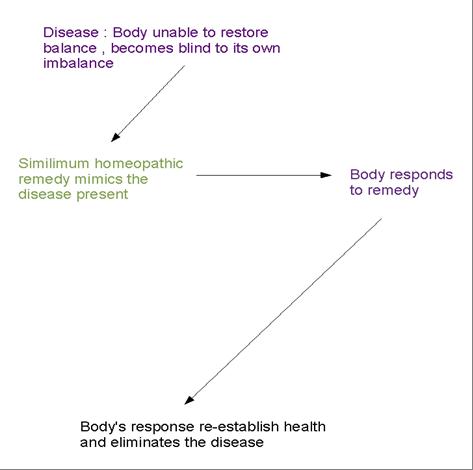
Infective agents
Infective agents are recognised as causing diseases and curing the patient from these agents is done through the vital force of the patient and it is asserted that a person with a healthy vital force will be able to eliminate any infection.[2]
The Homeopathic point of view of infectious diseases is that the infective agent does not cause the symptoms of the disease but it is the vital force which is deranged because of the infective agent which causes the symptoms of the disease, hence the treatment is directed at aiding the vital force to correct itself by using the homeopathic remedy which is capable of causing symptoms and thus acts as an artificial disease which the vital force will act against thus removing the disease and restoring the Vital Force which has the self correcting power.[2]
Hahnemann’s use of the term disease in the Organon meant the dynamic change (deviation from normal) in the vital force that could be noticed as symptoms and signs. Homeostasis is restored when the patient with the symptoms re – experiences the same dynamic changes. Since the body is not balanced because the vital force has become unaware of its deranged and changed state, a stimulus which resembles the original trigger for this derangement makes the body become more aware of its deranged state and thus it sets about correcting it.[37]
Homeopathic Practice
Important Points
Taken from Sixth Edition Organon of Medicine [2]:
- What is to be cured is what has deviated from the normal in the emotional, mental and physical planes.
- The patient is seen as a whole person and not as diseased parts.
- The causative factors and maintaining causes are looked into and when possible removed by suitable measures such as nutritional corrections, hygiene and mechanical means etc.
- Single remedies are given at any one time and the remedy given should match as closely as possible the presenting symptoms at the time of the prescription.
- Treatment is individualised and two people presenting with the same disease are not given the same remedy but are given the remedy that corresponds to the way the disease manifests in each of them.
Glossary of Homeopathic Terms
- Vital Force (VF): This is the vitality and life force of a person. It will always bring a person to a position of balance (health) if allowed to work freely. Disease is caused by chronic or acute miasms, which prevent the Vital Force from healing the patient.
- Proving: A substance is taken until it produces symptoms in the person taking it.
- Similimum: This is the remedy that is most similar to the disease in terms of the symptoms and signs produced in a homeopathic proving.
- Totality of symptoms: The signs and symptoms present in a person who is to be cured, which cover his emotional mental and physical aspects.
- Miasm: Infective agents that can be acute or chronic.[2]
- Succusion: Rythmitical violent agitations are carried out, either by hand or machine.[26]
- The Repertory: A book that lists all of the symptoms for the homeopathic single remedies. It is like an index for the Materia Medica.
- Rubrics are a set of words in a repertory that describe a symptom. Examples of rubrics are in the screenshot below from the homeopathy software called RADAR (Figure 8).
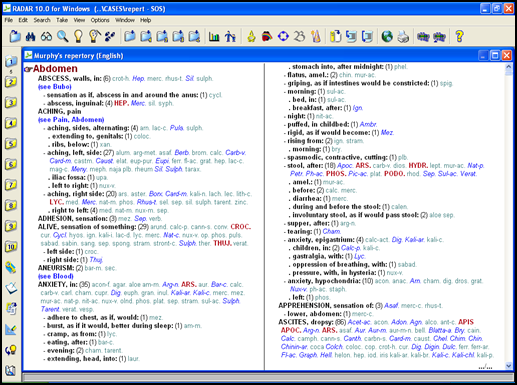
Figure 8: Screenshot of Rubrics from the Chapter Abdomen in Murphy’s Repertory in the Radar Software (see glossary above for explanation of the word rubrics)
In the above figure, a snapshot of the Chapter on Abdomen is shown. The words are arranged backwards so that if one were to search for “ Abscess in the wall of the abdomen, has to first search for Abdomen, then for the word abscess and look in the subrubrics for the words wall. When reaches this set symptom of abscess in the wall of the abdomen, the remedies that can treat this condition listed in abbreviation form can be found.
Diagnosis
The most important method of diagnosis in a Homeopathic practice is the case taking interview which may involve also interviewing people close to the patient such as relatives and close friends.[38]
Case Taking
Case taking in a homeopathic practice is for the following purposes:
- To know the diagnosis of the case. In a Homeopathic practice, the importance of diagnosis is to know the prognosis, understanding the pathology as well as identifying the aetiology (causative factor) of the disease of the patient and to find the similimum remedy.
- To know what remedy to prescribe and for this, apart from the conventional case taking, which is similar to an allopathic consultation (except that the homeopath will ask many additional questions), a homeopath needs to know the possible emotional and traumatic circumstances leading to the disease and in this will look for clues such as:
- When was the last time the patient was well.
- What happened just before the patient became ill.
- What diseases did the patient have and were there any complications such as slow recovery or lingering symptoms.
- To identify the nature of the miasm (infection) the patient is having and also whether it is in an acute state, a chronic state or a latent state. This comes from an analysis of the presenting signs and symptoms as well as the emotional state of the patient. More so – emotional conditions that have deviated from the patient’s norm or are in themselves abnormal such as constant irritability or constant anxiety are of great importance.
- To diagnose which ‘remedy state’ the patient is in, in order to come to a prescription. In homeopathic case taking, the mental and emotional state plays a key role in choosing the remedy. A Professional Homeopath on the subject of mental and emotional symptoms says that Homeopathy uses the mental and emotional component to connect the full picture of the patients suffering to the attributes of a remedy and the more complete the picture, the more likely he is to get the remedy homeopathic to the case and therefore the remedy would be curative.[39] The modalities of the presenting symptoms as well as the constitution of the patient and the temperament of the patient are taken into account in a homeopathic case taking while they are of no significance in an allopathic case taking.
Examination
Examination of the patient will include taking note of posture-, mannerisms-, nature and distribution of lesions site of pains and limitations in movement as well as the modalities of the pains-, i.e. what relieves the pains what makes it worse etc.
Investigations
Other than this, medical records and laboratory tests as well as x ray and other imaging reports are studied. This is done by professional homeopaths that have medical knowledge as well as medically trained homeopaths.
Medically trained homeopaths carry out the needed investigations and in an ideal situation-, lay and professional homeopaths will work with a medical doctor to facilitate investigations and obtain medical and surgical history.
Different Methodologies in Homeopathic Practice
This article has focused on Hahnemannian Homeopathy only. There are however a number of homeopaths since Hahnemann’s time who have developed different ways of prescribing by focusing on different aspects of Hahnemann’s teachings.
There are different methods[40] arriving at a homeopathic prescription and these are:
- Constitutional prescribing based on the person’s personality, likes and dislikes.
- Physical generals based on the patient’s physical and general symptoms.
- Organ treatment where the remedy used is one that is focused on the organ affected.
- Miasmatic prescribing where the prescription is based on the presenting miasm (a chronic infection that manifests as chronic disease).
- A specific prescribing is based on specific conditions that call for specific remedies.
- Genus epidemicus prescribing where the prescribed remedy is chosen from a group of remedies that have been identified as specific for an infectious outbreak in an epidemic.[2]
Below is a list of different perspectives of prescribing by different contemporary Homeopathic teachers:
- Jan Scholten[41] used the Periodic table to classify Elements and Metals into groups and he listed symptoms according to the Periodic table. It made it easier to find the themes of the patient and was directed towards healing the patient’s constitution
- Rajan Sankaran[42] introduced the concept of Kingdoms and classified plants and animals according to their species and listed characteristics of patients according to the species of remedies they needed. He expanded on Jan Scholten’s teachings.
- Sehgal[43] who founded his School of Revolutionized Homeopathy and focused on mind symptoms rather than body symptoms.
- Ardavan Shahrdar[44] introduced the concept of the viral miasms, which complete Samuel nemann’s theory of chronic diseases. He developed software called Repertorium Virosum that can be used to analyze chronic diseases using the research he has made into chronic diseases with a viral agent triggering the onset.
Types of Homeopathic Practice
Professionals
Medical Doctors, Nurses and Therapists
Medically trained doctors in hospital and clinic setting:
- In India and Pakistan, homeopathy is practiced in government and private hospitals but is usually a department in an allopathic hospital. According to Bhatia – a homeopathic doctor, owner of http://hpathy.com, in India, there is a large public and government support for homeopathy but the actual number of people taking homeopathic treatment in comparison to allopathic treatment is much smaller and the education being provided in the homeopathic colleges is not good enough for homeopaths to have separate hospitals.[45]
- In the United Kingdom there are several Homeopathic Hospitals and a homeopathic department in a Hospital.[46]
Some of the Homeopathic hospitals have formed units that treat conditions in an integrated manner-. An example of this is at the Royal London Homeopathic Hospital (RLUH) where there is an Allergy Environment and Nutritional Medicine unit. The clinic specialises in the diagnosis and treatment with allergic conditions and also other conditions in which diet and or the environment may play a part in causing the complaint. Their team consists of four doctors and dietician, a nurse practitioner and an occupational health therapist.[47][48]
This integrated approach would be in line with what is stated in paragraph 3 of Hahnemann’s Organon of Medicine and that is:
“If, finally, he knows the obstacles to recovery in each case and is aware how to remove them, so that the restoration may be permanent, then he understands how to treat judiciously and rationally, and he is a true practitioner of the healing art”.
In general, from communication with practicing homeopaths and visits to various homeopathic practices in India, Malaysia, US and the UK:
- Homeopathy is practiced in a clinic setting for walk-in patients in most homeopathic practices all over the world.
- Outpatients are seen in a consulting room for case taking and recording the history and also for examination of the patient and an examination couch necessary for this purpose.
- There are no procedures that are particular to homeopathy but medically trained doctors will manage a homeopathy case that needs minor surgery or other interventions and procedures as and when needed or will refer cases to the relevant specialties for the procedures or surgery.
- Emergencies and acute cases may be treated at the bedside and homeopaths are known to make house calls to treat such cases when needed.
Homeopathy can be used the Casualty Room of the hospital and a report was made on the use of homeopathy in the emergency room as in the abstract entitled Homeopathy In Emergency Medicine. It reported on the use of Homeopathic remedies prescribed by homeopaths in conventional hospitals in Austria and Israel. Through the study of documents from case series of casualty cases, they showed positive results in treating patients from the Emergency Department and wards. Of these, two cases showed remarkable homeopathic cures to terminally ill patients. Homeopathy was also demonstrated to be effective as compared to placebo in improving long term survival in cases of sepsis and hastened extubation. The conclusion of this report is that it was suggested that homeopathy could be applied for critically ill patients, with a few obstacles occurred due to the lack of tools for a good homeopathic prescription and the lack of support from conventional medicine doctors working in the same place. It also suggested that these problems should be overcome in the interest of improving patient management in the emergency room by using an integrated approach that is, combining homeopathic remedies with conventional treatment.[49]
Bedside prescribing has its own method, which requires training and skill since in acute cases the luxury of long case taking which is a key characteristic of prescribing for chronic diseases is neither possible nor advisable. John Henry Clarke wrote a book titled “The Prescriber” to aid homeopaths in bedside prescribing.[50]
There are homeopathic obstetricians who treat the complaints of the pregnant mother and the woman in labour with homeopathic remedies.[51]
Veterinarians
Besides Medicine, there are also homeopathic veterinarians.[52]
Dentists
There are also homeopathic dentists who prescribe homeopathic remedies in place of allopathic drugs.
Self Practice
- Homeopathy is popular throughout the world as a hometreatment administered by a non-professional lay homeopath or even an amateur who is not formally trained as a homeopath.
- Lay homeopath – A lay homeopath is an untrained homeopath that gets his knowledge from self learning. Professional homeopaths may not be doctors but are well trained and have studied at an established homeopathic college or school.
- This practice is not dangerous if the remedies used are those that have been allowed to be sold in health food stores and pharmacies without a prescription. Throughout Europe, UK, the US, Australia and New Zealand, there are many plant based and mineral based remedies that are allowed to be sold as non-prescription over the counter remedies. Many books arewritten to guide the individual in prescribing for a remedy.
There are also many websites that have information and guides to selecting remedies as well as online stores that sell non regulated homeopathic remedies which have been classified as non-poison items.
Diagnostic Tools in Homeopathic Practice
Diagnostic tools specific to homeopathy are needed for remedy selection. They were developed in the form of a Repertory in which symptoms were listed. The listed symptoms were called rubrics, while remedies were made by recognizing the symptoms of the rubrics. They were listed behind the rubrics.
Changing the patient’s symptoms into rubrics and then selecting the rubrics from the Repertory and then searching for the remedies that were present in all the patient’s rubrics helped the Homeopath select a remedy to prescribe.
Doing this proved to be a very long and tedious process and this was cut short and Homeopathic prescribing was revolutionized with the introduction of Homeopathic software, which is mentioned under the Homeopathic Timeline previously.
The most important Homeopathic software[53] are listed here:
- Radar (Figure 9, 10)
- Hompath (Figure 11)
- ISIS
- MacRepertory (Figure 12)
Training is needed to learn how to translate patient’s symptoms into rubrics and in selecting the symptoms to use in repertorization.
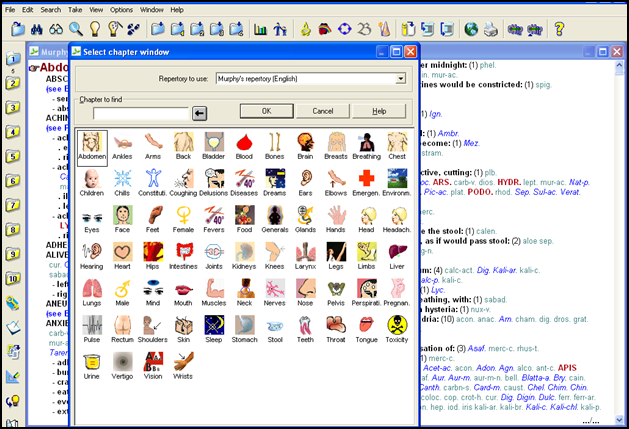
Figure 9: Screen Shot Of Radar Software
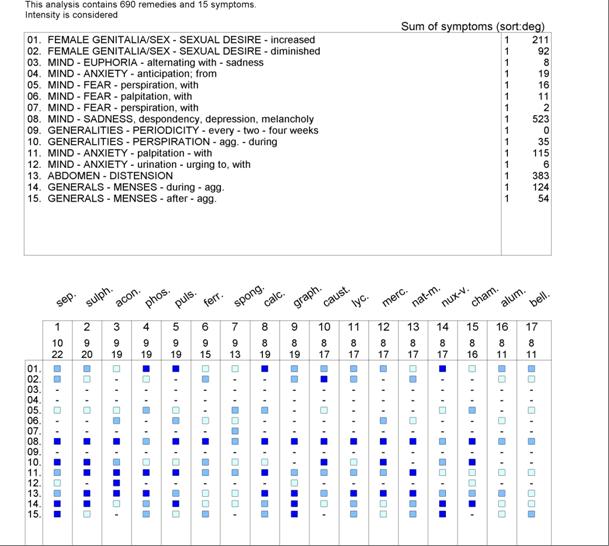
Figure 10: Screenshot of a Repertorization Using Radar Software
Explanation (Figure 10): A screenshot of a repertorization done using RADAR.
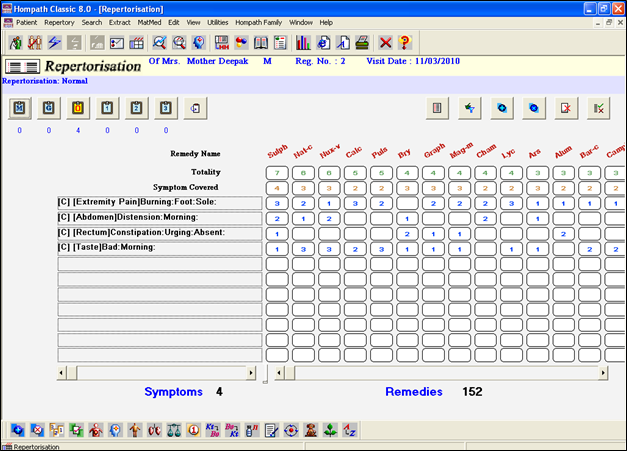
Figure 11: Screenshot of Repertorizing using Hompath
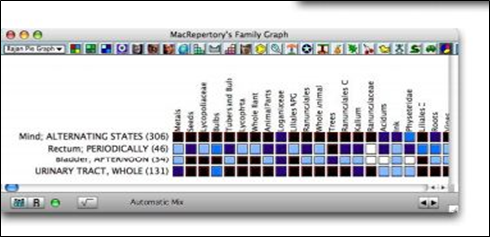
Figure 12: Macrepertory Screenshot
Scope of Treatment
Homeopathic practice comes with its range of therapeutic agents called homeopathic remedies and homeopaths have treated all manner of chronic diseases as well as acute and chronic infections.
The conditions which homeopaths report[54] had been helped either partially or completely with homeopathy include the following conditions. Homeopaths do not have different names for the diseases and use the same terms as in conventional medicine. This list below was compiled by homeopaths and there are clinical trials for some of the conditions listed below.
Other than this, since the compilation is by homeopath report, it cannot be validated and needs further trials.
- ADHD
- Acne (Rosacea)
- Arthritis
- Asthma
- Back Problems
- Bell ’s palsy
- Bronchitis
- Chronic Fatigue and ME
- Colds and Coughs
- Colic
- Croup
- Cystitis
- Depression and emotional problems
- Digestive problems – IBS, colitis, diverticulitis
- Ear pain and infections
- Eczema
- Fibroids
- Flu
- Gallstones
- Glandular Fever
- Gout
- Hay fever
- Herpes- cold sores, genital herpes, chicken pox and shingles
- High Blood Pressure
- Hormonal problems – period pain, absent or irregular periods, heavy bleeding and menopausal difficulties
- Hypo and hyper-active thyroid
- Infertility
- Insomnia
- Laryngitis
- Meniere’s Disease
- Multiple Sclerosis
- Parkinson’s Disease
- Pelvic Inflammatory Disease
- Pharyngitis
- Polyps
- PMT
- Pregnancy and Labour
- Prostate difficulties
- Psoriasis
- Raynaud’s Disease
- Rheumatism
- Ringworm
- Sinusitis
- Strokes
- Tendonitis
- Thrush
- Tonsillitis
- Travel Sickness
- Vaccinations (problems since and alternatives to)
- Whooping Cough
- Worms
A Database compiled by Homeopaths of their cured cases can be found at Homeopathy- clinical cases.
Key trials on some conditions will be discussed under the topic Research (link).
References
- International Academy of Classical Homeopathy. The Basic Principles of Homeopathy. [Online]. Available from: http://www.vithoulkas.com [Accessed 8th Jan 2011].
- Hahnemann SCF. Organon of Medicine. 6th ed. [Online]. Available from: http://www.homeopathyhome.com [Accessed 6th Oct 2009] [paragraph 275, 9-11. 290, 294, 274, 31, 22,48, 3-5, 146-171, 153, 72-81, 101].
- Farlex. Similimum Definition. [Online]. Available from: http://medical-dictionary.thefreedictionary.com/simillimum [Accessed 20th June 2010].
- Hpathy. Materia Medica Pura – Samuel Hahnemann. [Online]. Available from: http://hpathy.com [Acessed 20th June 2010].
- Dantas F., et. al. A Systematic Review of the Quality of Homeopathic Pathogenetic Trials Published from 1945 to 1995. Homeopathy. 2007; 96(1)pp. 4-16.
- Hahnemann SCF. Materia Medica Pura. India: B. Jain Pub Pvt Ltd; 1846.
- Clarke JH. Clarke’s Dictionary of Material Medica.1st ed. India: B. Jain Pub Pvt Ltd.; 1978.
- Murphy Robin B. Lotus Materia Medica. India: Jain Publishers (P) Ltd; 2003.
- Boericke, W.M.D. Boericke’s Materia Medica. Arnica Montana. [Online]. Available from: http://www.homeoint.org [Accessed 20th June 2010].
- Boericke, W.M.D. Boericke’s Meteria Medica. Belladona. [Online]. Available from: http://www.homeoint.org [Accessed 20th June 2010].
- Boericke, W.M.D. Boericke’s Materia Medica. Berberis Vulgaris. [Online]. Available from: http://www.homeoint.org [Accessed 20th June 2010].
- Boericke, W.M.D. Boericke’s Materia Medica. Hyoscyamus Niger. [Online]. Available from: http://www.homeoint.org [Accessed 20th June 2010].
- Boericke, W.M.D. Boericke’s Materia Medica. Chamomilla. [Online]. Available from: http://www.homeoint.org [Accesseed 20th June 2010].
- Boericke, W.M.D. Boericke’s Materia Medica. Lachesis Mutus. [Online]. Available from: http://www.homeoint.org [Accessed 20th June 2010.
- Boericke, W.M.D. Boericke’s Materia Medica. Sepia Officinalis. [Online]. Available from: http://www.homeoint.org [Accessed 20th June 2010].
- Boericke, W.M.D. Boericke’s Materia Medica. Apis Mellifica. [Online]. Available from: http://www.homeoint.org [Accessed 20th June 2010].
- Boericke, W.M.D. Boericke’s Materia Medica. Ferrum Metallicum. [Online]. Available from: http://www.homeoint.org [Accessed 20th June 2010].
- Boericke, W.M.D. Boericke’s Materia Medica. Natrium Muriaticum. [Online]. Available from: http://www.homeoint.org [Accessed 20th June 2010].
- Boericke, W.M.D. Boericke’s Materia Medica. Phosphorus. [Online]. Available from: http://www.homeoint.org [Accessed 20th June 2010].
- Boericke, W.M.D. Boericke’s Materia Medica.Sulphur. [Online]. Available from: http://www.homeoint.org [Accessed 20th June 2010].
- Boericke, W.M.D. Boericke’s Materia Medica.Platinum Metallicum. [Online]. Available from: http://www.homeoint.org [Accessed 20th June 2010].
- Boericke, W.M.D. Boericke’s Materia Medica.Aurum Metallicum. [Online]. Available from: http://www.homeoint.org [Accessed 20 June 2010].
- HPUS overview. [Online]. Available from: http://www.hpus.com [Accessed 20 June 2010].
- Jyothis Ram. A Quick Review in Homeopathic Pharmacy. [Online]. Available from: http://www.similima.com [Accessed 20th June 2010].
- Ministry of Health & Family Welfare. Government of India. Quality Control of Homeopathic Drugs. [Online]. Available from: http://hplism.nic.in/qc.htm [Accessed 20th June 2010].
- Kaynes, Steven B. Homeopathic Pharmacy: Theory and Practice. China: Elsevier Health Sciences. 2006.
- Scholten J. Homeopathy is Effective. [Online]. Available from: http://www.janscholten.com [Accessed 5th Oct 2009].
- Hpathy. Preparation of Drugs & Homeopathic Scales of Dilution. [Online]. Available from: http://www.hpathy.com [Accessed 1st Nov 2009].
- Home Shopping Pharmacy. More Information About Your Homeopathic Medications. [Online]. Available from: http://www.homeshoppingpharmacy.com [Accessed 20th June 2010].
- Hahnemann Labs. Methods of Preparation of Homeopathic Medicines. [Online]. Available from: http://hahnemannlabs.com/preparation.html [Accessed 8th Jan 2011].
- H.O.E. Hahnemann Advanced Method [Online]. Available from: http://www.simillimum.com [Accessed 8th Jan 2011].
- Little D. Hahnemann’s Advanced Methods Part 2: The Medicinal Solutions. [Online]. Available from: http://hpathy.com[Accessed 20th June 2010].
- Book review: Hahnemann Samuel:Organon of Medicine. 6th ed. [Online]. Available from: http://www.minimum.com [Accessed 20th June 2010].
- H.O.E. Comparison Between of C and LM Potencies. [Online]. Available from: http://www.simillimum.com [Accessed 8th Jan 2011].
- Quinn M. Methods of Preparation of Homeopathic Medicines. [Online]. Available from: http://www.wholehealthnow.com [Accessed 20th June 2010].
- Proving Subcommittee: ECH. Available from: European Committee for Homeopathy. Homeopathy provings Guideline (Ver. 1). [Online]. Available from: http://www.homeopathyeurope.org [Accessed 20th Jun 2010].
- Shahdar A. Homeopathy,the Concept. [Online]. Available from: http://minutus.org [Accessed 1st Nov 2009].
- Schmidt P. The Art of Interrogation. [Online]. Available from: http://homeoinfo.com 2003 [Accessed 5th Oct 2009].
- King S. Studying Emotional and Mental Symptoms in Homeopathic Case-taking. [Online]. Available from: http://homepage.ntlworld.com [Accessed 5th Oct 2009].
- Ian Watson. A Guide to the Methodologies of Homeopathy. 2nd ed. Devon (London): Cutting Edge Publications; 2004. p. v.
- Scholten J. Life. [Online]. Available from: http://www.janscholten.com [Accessed 5th Oct 2009].
- Sankaran R. Survival. [Online]. Available from: http://hmp.rajansankaran.com [Accessed 5th Oct 2009].
- Sehgal M. L. Sehgal Method. [Online]. Available from: http://www.ssrhindia.com [Accessed 5th June 2010].
- Shahrdar A. About Materia virosa and Repertorium virosum. [Online]. Available from: http://www.repertoriumvirosum.com [Accessed 5th Oct 2009].
- Bhatia M. Time Again for Homeopathy Hospitals?. [Online]. Available from: http://hpathy.com [Accessed 20th June 2010].
- British Homeoapthic Association. NHS Homeopathic Treatment. [Online]. Available from: http://www.britishhomeopathic.org [Accessed 7th Apr 2009].
- UCLH: Royal London hospital for Integrated Medicine. Home. [Online]. Available from: http://www.uclh.nhs.uk [Accessed 8th Jan 2011].
- UCLH: Royal London Hospital for Integrated Medicine. Adult Allergy.[Online]. Available from: http://www.uclh.nhs.uk [Accessed 8th Jan 2011 Jan 8].
- Oberbaum M, Singer SR, Friehs H, Frass M. Homeopathy in Emergency Medicine. Wien Med Wochenschr [Serial online] 2005 Nov; 155(21-22);[491-7 pages]. Available from: http://www.ncbi.nlm.nih.gov [Accessed 1st Oct 2009].
- Médi-T. The Prescriber by John Henry Clarke. [Online]. 2003. Available from: http://www.homeoint.org [Accessed 24th Jan 2011].
- Healthy.net. Pregnancy and Labour: Getting off to a Good Start.[Online]. 2010?.Available from: http://www.healthy.net [Accessed 8th January 2011] from Dana Ullman. Discovering Homeopathy: Medicine for the 21st Century. Berkeley (California): North Atlantic Books; 1991.p. 107- 117.AVMC – Holistic Veterinary Medicine.Homeopathic Veterinary. [Online]. Available from: http://www.veterinary-holistic.co.uk/homeopathy.html [Accessed 5thOct 2010]
- Hpathy. Homeopathic Medicine and Homeopathic Remedies. [Online]. Available online: http://hpathy.com/homeopathy-software/ [Accessed 20th June 2010].
- ENHR. An Overview of Positive Homeopathy Research and Surveys. [Online]. Available from: http://www.homeopathy-soh.org [Accessed 20th March 2010].


